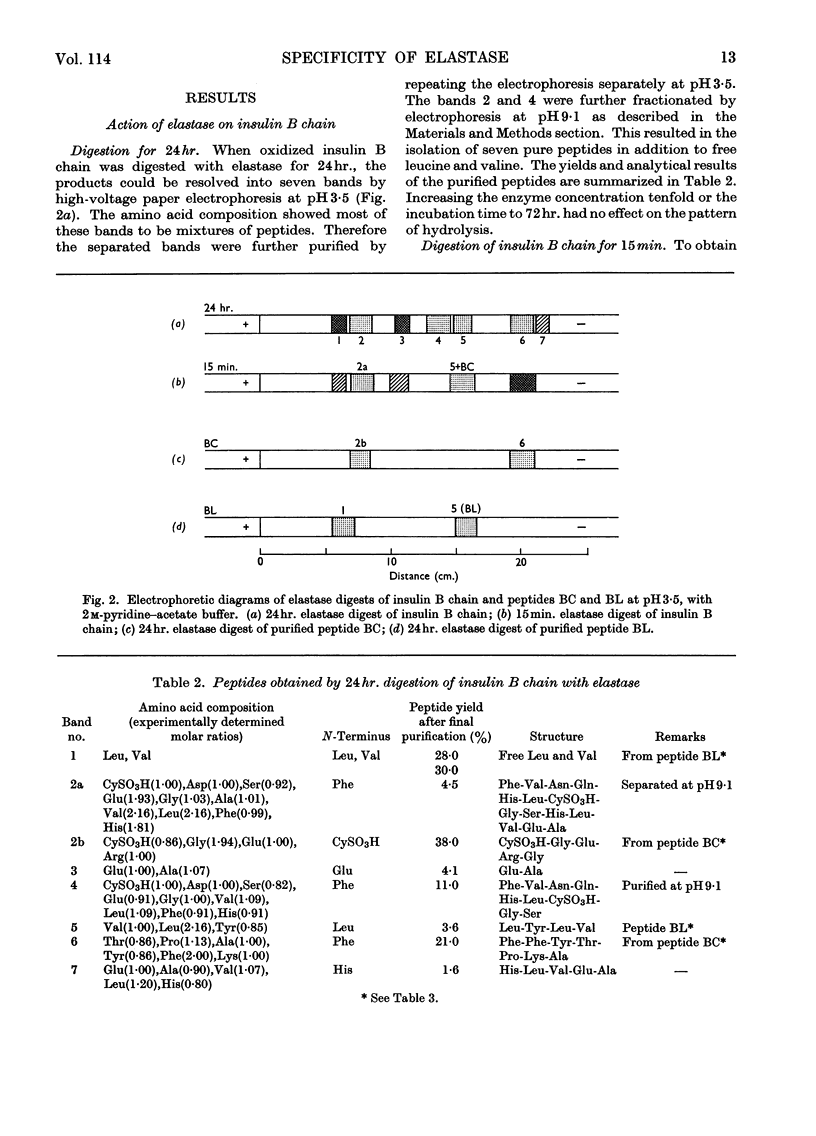Abstract
An electrophoretically homogeneous elastase preparation free from tryptic and chymotryptic activities was obtained by chromatography on DEAE-Sephadex and CM-cellulose. This preparation exhibits a narrower specificity towards peptide bonds than that observed by Naughton & Sanger (1961). With oxidized insulin B chain as substrate, the fastest breaks occur between alanine-14 and leucine-15 and between valine-18 and cysteic acid-19. The bond between glycine-23 and phenylalanine-24 is also efficiently hydrolysed. Other bonds hydrolysed are that between valine-12 and glutamic acid-13 and that between serine-9 and histidine-10. Oxidized insulin A chain is hydrolysed only at one of two points, between alanine-8 and serine-9 or between serine-12 and leucine-13, and the rate of hydrolysis is very low.
Full text
PDF






Selected References
These references are in PubMed. This may not be the complete list of references from this article.
- BRINK N. G., LEWIS U. J., WILLIAMS D. E. Pancreatic elastase: purification, properties, and function. J Biol Chem. 1956 Oct;222(2):705–720. [PubMed] [Google Scholar]
- Barman T. E., Koshland D. E., Jr A colorimetric procedure for the quantitative determination of tryptophan residues in proteins. J Biol Chem. 1967 Dec 25;242(23):5771–5776. [PubMed] [Google Scholar]
- Brown J. R., Kauffman D. L., Hartley B. S. The primary structure of porcine pancreatic elastase. The N-terminus and disulphide bridges. Biochem J. 1967 May;103(2):497–507. doi: 10.1042/bj1030497. [DOI] [PMC free article] [PubMed] [Google Scholar]
- Gertler A., Hofmann T. The involvement of the amino-terminal amino acid in the activity of pancreatic proteases. I. The effects of nitrous acid on elastase. J Biol Chem. 1967 May 25;242(10):2522–2527. [PubMed] [Google Scholar]
- Ling V., Anwar R. A. On the presence of two distinct proteolytic components in pancreatic crystalline elastase. Biochem Biophys Res Commun. 1966 Sep 8;24(5):593–597. doi: 10.1016/0006-291x(66)90363-9. [DOI] [PubMed] [Google Scholar]
- NAUGHTON M. A., SANGER F. Purification and specificity of pancreatic elastase. Biochem J. 1961 Jan;78:156–163. doi: 10.1042/bj0780156. [DOI] [PMC free article] [PubMed] [Google Scholar]
- PIEZ K. A., MORRIS L. A modified procedure for the automatic analysis of amino acids. Anal Biochem. 1960 Nov;1:187–201. doi: 10.1016/0003-2697(60)90045-2. [DOI] [PubMed] [Google Scholar]
- REISFELD R. A., LEWIS U. J., WILLIAMS D. E. Disk electrophoresis of basic proteins and peptides on polyacrylamide gels. Nature. 1962 Jul 21;195:281–283. doi: 10.1038/195281a0. [DOI] [PubMed] [Google Scholar]
- SMITHIES O. Zone electrophoresis in starch gels and its application to studies of serum proteins. Adv Protein Chem. 1959;14:65–113. doi: 10.1016/s0065-3233(08)60609-9. [DOI] [PubMed] [Google Scholar]
- STARK G. R., SMYTH D. G. The use of cyanate for the determination of NH2-terminal residues in proteins. J Biol Chem. 1963 Jan;238:214–226. [PubMed] [Google Scholar]
- Smillie L. B., Hartley B. S. Histidine sequences in the active centres of some 'serine' proteinases. Biochem J. 1966 Oct;101(1):232–241. doi: 10.1042/bj1010232. [DOI] [PMC free article] [PubMed] [Google Scholar]
- Smillie L. B., Whitaker D. R. Amino acid sequence around the histidine residue of the alpha-lytic protease of Sorangium sp., a bacterial homolog of the pancreatic serine proteases. J Am Chem Soc. 1967 Jun 21;89(13):3350–3352. doi: 10.1021/ja00989a046. [DOI] [PubMed] [Google Scholar]
- Whitaker D. R., Roy C., Tsai C. S., Jurásek L. Lytic enzymes of Sorangium sp. A comparison of the proteolytic properties of the alpha- and beta-lytic proteases. Can J Biochem. 1965 Dec;43(12):1961–1970. doi: 10.1139/o65-219. [DOI] [PubMed] [Google Scholar]


